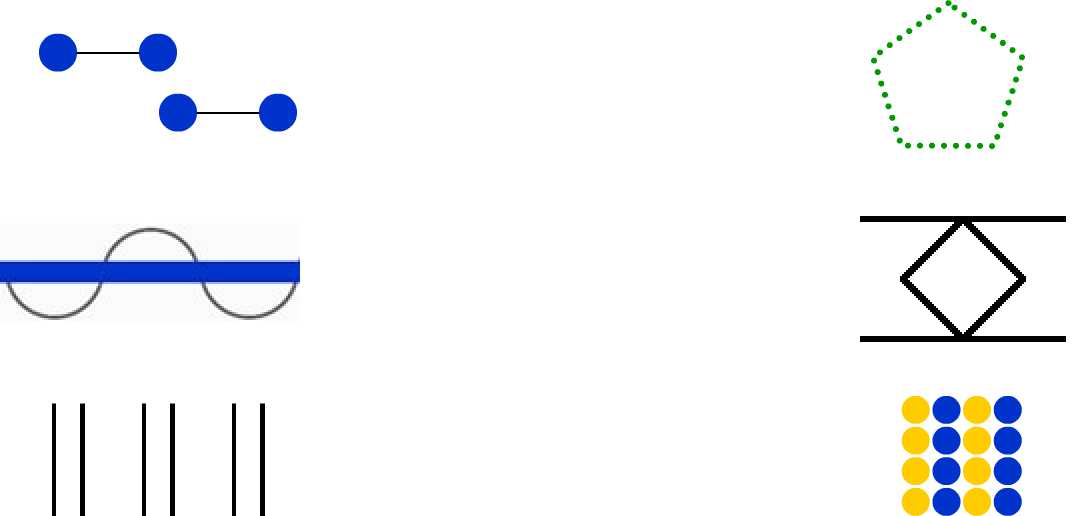Chapter 34. Perceptual Grouping
Learning Objectives

Describe six major principles of perceptual grouping.
Identify an example of each major principle of perceptual grouping.
Review
Review
Select the NEXT button to continue with the Review.

1. Our brains are constantly filtering sensory information, breaking it down into bits and pieces and assembling the pieces in different ways until we arrive at a perception of the visual scene that makes sense to us.
Review
Review
Select the NEXT button to continue with the Review.

2. How do we decide which of the pieces belong together? The principles of perceptual grouping were first identified by researchers called the Gestalt psychologists (Gestalt is a German word translated as a "complete form" or a "whole figure"). We now refer to those rules as the Gestalt principles of perceptual organization.
Review
Review
Select the NEXT button to continue with the Review.

3. Six of the important Gestalt principles are proximity (grouping nearby objects); similarity (grouping objects that have the same shape or color); continuity (grouping objects to form smooth, continuous shapes); connectedness (grouping objects that are linked by lines); closure (filling in gaps between objects to form a complete shape); and simplicity (grouping objects to form the most familiar, symmetrical shape possible).
Practice 1: Proximity
Practice 1: Proximity
Select the PLAY button to demonstrate the proximity principle.
The proximity principle of perceptual grouping flows from the spatial relationships among objects. We have a tendency to perceive objects as a group if they occur close together in space. In the figure below, we tend to group the six lines into three sets of two lines (or three thin pipes) on the basis of proximity. We generally do not group the lines into two wide pipes enclosed in a larger pipe.
Practice 2: Similarity
Practice 2: Similarity
Select the PLAY button to watch the similarity principle in action.
The similarity principle states that we tend to perceive objects as a group if they are similar in shape, color, or surface texture. We perceive the figures below as rows of similar objects rather than as columns of mixed objects.
Practice 3: Closure
Practice 3: Closure
Select each of the PLAY buttons to demonstrate the closure principle.
The closure principle of perceptual grouping predicts that we will perceive "broken" or incomplete lines as complete objects by filling in the gaps. Keep in mind that what you are actually “seeing” are only dark blobs on a light background. Your brain fills in the spaces between the blobs so that you “perceive” complete, recognizable shapes.
What you actually see are dark blobs on a light background. Your brain probably filled in the gaps between the blobs to perceive complete shapes.
Practice 4: Connectedness
Practice 4: Connectedness
Select the PLAY button to demonstrate the connectedness principle.
According to the principle of connectedness, we tend to perceive objects as a group if they are linked by connecting lines or other shapes. For example, in the set of blue circles below, there are no connecting lines, so your perceptual system probably groups the center two circles together according to proximity. However, when you select the PLAY button, the lines connecting the circles help you group the left two circles together and the right two circles together.
Practice 5: Continuity
Practice 5: Continuity
Select the PLAY button to demonstrate the continuity principle.
The continuity principle states that we tend to group objects so as to perceive smooth, continuous patterns rather than discontinuous ones. In the figure below, we tend to group the gray curves together to form a smooth, continuous line, rather than treating each curve as a separate object.
Practice 6: Simplicity
Practice 6: Simplicity
Select the PLAY button to demonstrate the simplicity principle.
According to the simplicity principle, we tend to group objects so as to perceive the simplest, most symmetrical object possible from the raw sensory data. For example, if the sensory information can be organized to produce a square, or circle, or triangle, that is probably what we will perceive.
Quiz 1
Quiz 1
Match the Gestalt principles to their descriptions by dragging each colored circle to the appropriate gray circle. When all the circles have been placed, select the CHECK ANSWER button.
Quiz 2
Quiz 2
Drag each grouping principle to the gray area near the matching illustration. When all grouping principles have been placed, select the CHECK ANSWER button.

Conclusion
